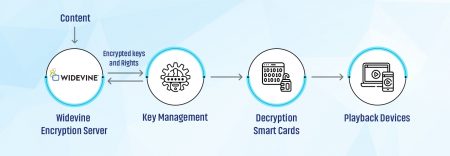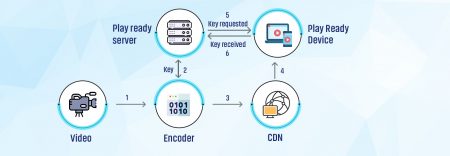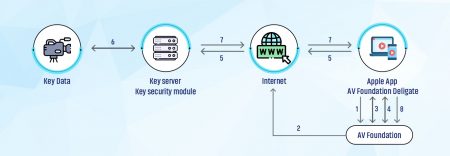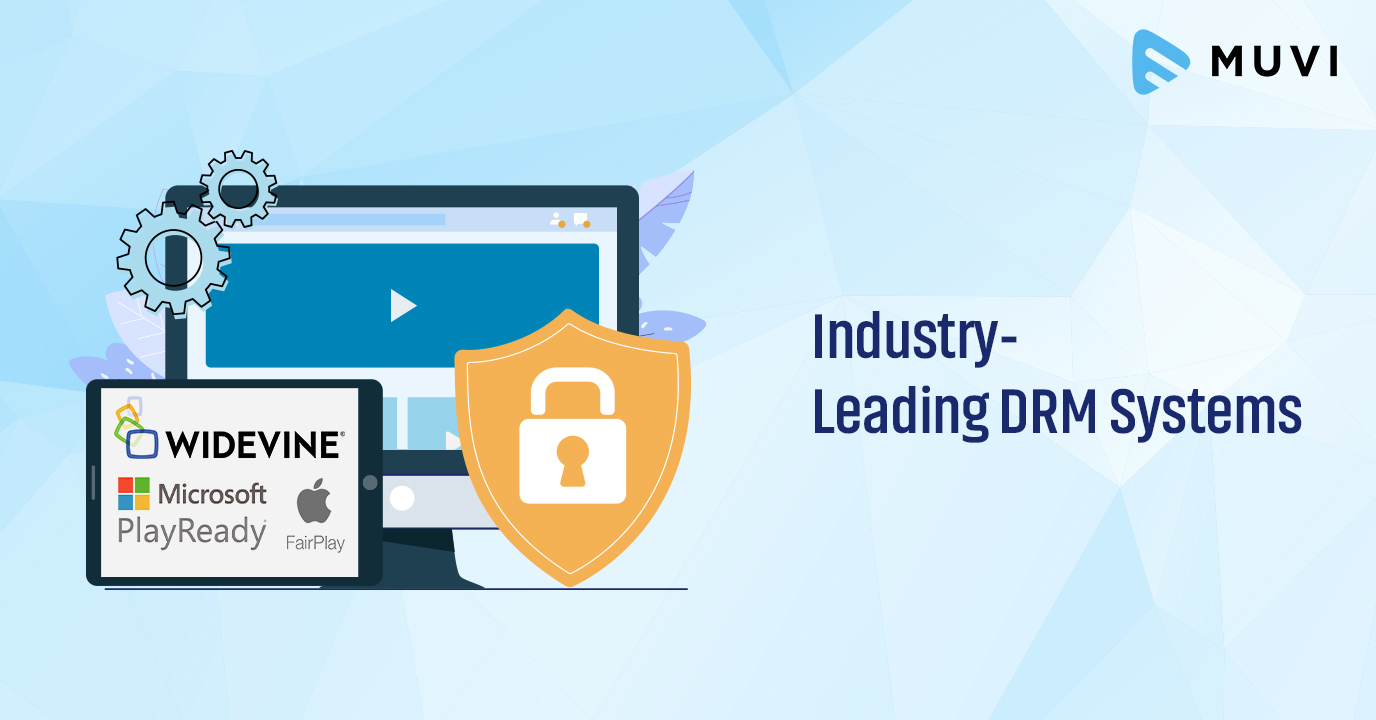Digital Rights Management is a highly sophisticated system to protect the unauthorized usage of video content for OTT streaming platforms. We have already discussed DRM and how important it is in content protection. In the previous blog, we also explained the workflow of the DRM in detail. In this blog, we will dig deeper on major DRMs that exist in the market. Let’s dive into the details.
Significant types of DRMs in the market – Working, Advantages, and Drawbacks
- Google Widevine DRM
- Microsoft PlayReady DRM
- Apple FairPlay DRM
Google Widevine
Acquired by Google in 2010, Widevine Technology has developed a DRM plugin that is built on top of the Android framework and offers advanced copy protection for Android devices. Widevine DRM prevents piracy using Chromium, an open-source web browser by Google. It is used by significant OTT content services around the globe, including YouTube, Hulu, Amazon, Netflix, and more. It is considered a popular choice among content creators as it allows them to deliver premium content securely across various kinds of devices and platforms. It also supports a large number of browsers including Chrome, Opera and Android TV. etc.
Widevine uses a combination of CENC encryption, adaptive streaming quality, and licensing key exchange to manage and send the video to users. It simplifies the work for service providers and supports the multi-level streaming quality based on the receiving device’s security capability.
There are two types of Widevine DRMs:
Classic Widevine DRM
The Classic Widevine DRM relies on AES encryption and supports Android OS 3.0 onwards. It uses MP4, HTML5 and WebM, making it highly compatible to most Smart TVs including Samsung TV now introduce samsung app development and Google TV.
2. Modular Widevine DRM
Modular Widevine DRM solution uses Dynamic Adaptive Streaming (over HTTP (DASH), Common Encryption (CENC), and Encrypted Media Extensions to enhance device capabilities and remove various restrictions on the client’s device. As it uses EME, it is supported by devices having Android OS 4.3 onwards making it compatible with chrome browsers and most New-Gen smart TVs.

Advantages of Widevine DRM
- It provides reliable content protection across the multiple devices and platforms
- Provides Hardware Security
- Widevine has standardized media container formats with support to MP4 and WebM
- Compatibility with HTML5, offers complete control, flexibility and overall functionality Highly compatible with the legacy systems
Drawbacks
Widevine DRM is considered as an L3 level of security when it comes to browser support. But, it keeps on innovating with newer versions working towards building better security.
Microsoft PlayReady DRM
Introduced by Microsoft in 2007, PlayReady was developed for protection for streaming content and is compatible with Smartphones, Playready devices, Set top boxes and PCs. It offers comprehensive security for content delivery and management with support for offline content and stream-only content . It includes restrictive license agreements, acquisition, and encryption to create a secured environment for digital content for the user. It supports various protection technologies and is suitable for subscription techniques like pay-per-view, periodical subscription and an ad-based system. It covers all the benefits that are provided by Apple’s FairPlay and Google’s Widevine.
The PlayReady DRM works on 3 servers:
1. Licensing Server
The licensing server stores all the licences that is used by viewers at the time of content playback
2. Domain Server Controller
The domain controller maintains several servers including the one that stores the subscriber’s information. It also controls the subscriber capacity or population that can join a particular domain
3. Metering Server
Metering Server is used to analyse the user behaviour based on the frequency the content is viewed/downloaded. When the user’s device sends a request for playback, the metering server updates the content playback information without causing any lag/latency issues.
encrypts the packaged and encrypted content and sends it ahead to the content distribution server. The license and encryption keys are then sent to the license server, and the domain information is sent to the domain server. When the user hits the play button, the player recognizes the contents encrypted and communicates this to the CDM (Content Decryption Module) in the browser. The CDM generates the license request, and the player sends it to the license server. The license server then verifies the user’s authenticity and subscriber information, once the authentication is done, the server sends a license to the playback device to play the content.

Advantages of Microsoft PlayReady
- PlayReady is widely used DRM in the world which Proven, Versatile and Scalable
- Provides secure delivery by giving unique licenses to each and every client
- It enables and protects the content with standard AES and ECC cryptography
- It offers flexible business models that enable versatile user scenarios, including subscription services, rentals, and single purchases.
- Supports multi platforms including iOS, Android and Windows
- Has multi-codec support such as H.26, H.264, H.265
Drawbacks
The initial setup is a bit complex, and sometimes the runtimes are slow . There are no other potential drawbacks to Microsoft PlayReady.
Apple FairPlay
Veridic was the first company to develop FairPlay DRM, it was later adopted by Apple, to be primarily usedfor its iTunes media services. It was developed in 2015. It delivers the streaming media content securely to the client devices via HTTP live streaming protocol. The FPS technology enables the content providers, encoding vendors, and the CDNs to encrypt the content and securely exchange the keys to protect the playback on iOS, Mac, and iOS Safari browsers.
When the user accesses the content provider’s application and hits the play button to watch the content, the app notifies the AV Foundation framework developed by Apple for the time-based audio-visual media. It provides video play and the location of the m3u8 playlist for HLS streaming. AVFoundation downloads the m3u8 files and parses them. It searches the file for the key tag to see whether the video is encrypted or not. If it is encrypted, the AVFoundation app delegates the content key to decrypt the content. It also delegates the requests of the AVFoundation Framework to generate Server Playback Content (SPC) messages. Once received, the KSM (Key Security Module) unwraps SPC and wraps it into CKC(Context Key Context). Hence it securely decrypts, decodes, and displays the content to the user.

Advantages of Apple FairPlay Streaming
- Enterprise protection to HLS audio and video
- Uses critical systems and adopted in the industry
- Integrates completely with AirPlay
- It supports the dynamic DRM business rules as per the license request.
- FairPlay offers stringent security for Hollywood studios and major broadcasters in premium content licensing.
- Enables rapid deployment, simple and efficient
Drawbacks
It is difficult to convert it into another format, which is the only drawback in Apple’s FairPlay DRM.
We hope you understood the major types of DRMs available in the market, how they secure digital content, and their advantages and drawbacks. If you are new to this blog and want to start from the basics for DRM, , please do read our previous blog in the DRM series. Besides these types, there are also other versions of each DRMs and encryption methodologies, such as Multi DRMs and its types. We will discuss that in our upcoming blog along with its implementation and usage.
Muvi is at the cusp of DRM security features and technology, with our in-built DRM that utilizes a combination of all available DRMs and provides the best device and browser compatibility. At Muvi, you can start your own OTT platform without any hassles by trying out our 14-day free trial and secure your content platform.
















Add your comment